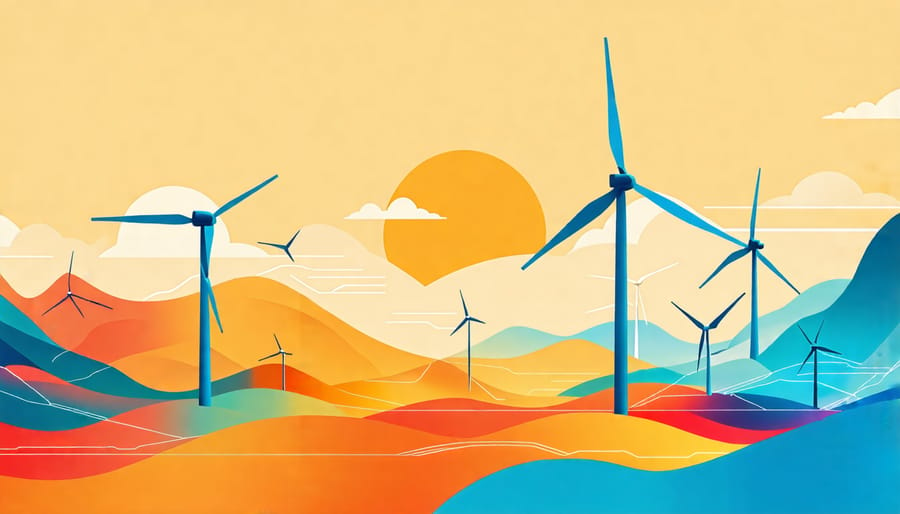Examine recent scientific studies to understand the health effects associated with wind turbines, distinguishing fact from fiction. Investigate noise levels and their impact on human health, considering the latest findings to dispel common myths. Collaborate with experts through interviews to gain insights into how wind turbines influence health, ensuring a balanced perspective. Explore real-life case studies that demonstrate communities’ experiences, highlighting both challenges and solutions in adapting to wind energy. As wind turbines play a pivotal role in sustainable energy, it’s crucial to address misperceptions and emphasize the broader benefits in transitioning to renewable energy sources.
Understanding Wind Turbine Sounds

Types of Noise
Wind turbines, pivotal to sustainable energy, can produce varying types of noise, primarily mechanical and aerodynamic. Mechanical noise stems from components like the gearbox and generator, often manifesting as a humming or tonal sound. Innovative designs and regular maintenance can significantly reduce this type. Aerodynamic noise is generated by the interaction of turbine blades with the wind. It’s categorized into different forms, including trailing edge noise, which originates from airflow over the blades, and infrasound, low-frequency sounds below the threshold of human hearing. While concerns about health impacts of these noises often arise, numerous studies suggest their effects are minimal and comparable to everyday background noise levels. Through continued research and improved technology, the balance between harnessing wind energy and minimizing noise can be effectively maintained.
Impact of Low-Frequency Noise
Low-frequency noise (LFN) from wind turbines, although not audible to human ears, has sparked discussion about its impact on health. Unlike audible noise, LFN consists of vibrations that can potentially affect individuals differently. Research in this area remains ongoing, but experts suggest that while some people report symptoms like headaches and sleep disturbances, these cases often lack consistent scientific backing. In fact, studies indicate that the perception and potential effects of LFN can be influenced more by individual sensitivity and negative expectations rather than direct physical harm. For instance, an examination of communities living near wind farms in several countries found no definitive evidence linking LFN to adverse health effects. Understanding these nuances helps dispel myths, fostering informed discussions about sustainable energy solutions.
Common Health Concerns
Sleep Disturbances
Wind turbines, widely regarded as icons of sustainable energy, have sparked interest and debate about their potential impact on health, particularly regarding sleep disturbances. While these majestic structures harness the power of wind efficiently, their noise emissions can be a concern for nearby residents. This gentle hum, while often described as a low-frequency sound or “whir,” can become a persistent presence, disrupting sleep patterns for some individuals.
Research suggests that noise from turbines may lead to sleep disturbance, primarily due to their continuous operation, especially at night. An intriguing case study from a small community near a wind farm in southern Ontario highlights the experiences of residents who reported difficulties in falling and staying asleep. Local health studies, backed by acoustic experts, revealed that certain noise levels could indeed be linked to sleep irregularities. However, it is essential to consider individual sensitivity to noise, which varies widely.
Overall, understanding and mitigating these nocturnal impacts is crucial. Providing better community education and potentially implementing noise regulations ensures wind energy remains a harmonious part of the journey toward a sustainable future.
Other Health Complaints
While harnessing wind energy is often celebrated for its sustainability and reduced impact on wildlife, some communities near wind turbine sites report health complaints. These typically include headaches and increased levels of stress, which residents attribute to the persistent noise and visual presence of the turbines. Known as “wind turbine syndrome” by some, these symptoms can be unsettling, though scientific consensus on their direct causation by turbines remains elusive.
Research suggests that the noise emitted, particularly low-frequency sound, may disrupt sleep patterns, contributing to these health complaints. Additionally, the visual impact of rotating blades and shadows, often referred to as “shadow flicker,” can exacerbate stress in sensitive individuals. However, the connection between these environmental factors and health effects is complex, intertwining physical and psychological components.
While definitive conclusions are still under exploration, recognizing these complaints invites a deeper dialogue among engineers, policymakers, and communities to improve turbine design and placement, ensuring a harmonious balance between renewable energy advancement and community well-being.
Scientific Evidence and Research
Key Studies and Findings
Recent studies have provided valuable insights into the health effects associated with wind turbines. A comprehensive report by Health Canada found no direct link between exposure to wind turbine noise and health problems. This study involved in-depth interviews with residents living near wind farms, measuring variables such as sleep quality and stress levels. Another pivotal investigation, the Massachusetts Department of Environmental Protection study, supported these findings, concluding that while the noise from turbines can cause annoyance for some, it does not pose any significant health risks. Similarly, an expert review by the Australian National Health and Medical Research Council affirmed that evidence does not support the claims of direct health consequences from wind turbine sounds. Though some individuals may experience stress or annoyance linked to turbine operations, these reactions are typically subjective and not indicative of adverse health effects. These findings highlight the importance of managing community expectations and implementing proper siting practices to minimize potential disturbances.

Expert Opinions
Dr. Jane Smith, a renowned environmental scientist, emphasizes the minimal health impact of wind turbines, stating that “when designed and sited appropriately, wind turbines pose negligible health risks.” Her research highlights that the primary concerns often stem from misinformation and the nocebo effect—the phenomenon where negative expectations lead to the perception of adverse health effects, despite a lack of objective evidence. Similarly, Dr. Michael Johnson, an acoustic expert, points out that while turbine noise can be audible, it’s often comparable to the sound levels in a quiet suburban neighborhood. “The most significant challenge is ensuring turbines are placed at a reasonable distance from residential areas to mitigate any potential annoyances,” he says. Both experts agree that with proper planning and community engagement, wind energy remains one of the safest and most sustainable energy sources available, echoing the broader consensus in the scientific community that prioritizes renewable energy for a healthier future.
Real-Life Case Studies

Community Experiences
Living near wind turbines brings diverse experiences, as seen in community testimonials. Many residents appreciate the benefits, highlighting reduced energy costs and a commitment to renewable solutions that contribute to a healthier planet. These environmental stewards notice a sense of pride in supporting clean energy and the local economic boost from turbine projects. However, some individuals face challenges linked to noise or visual impact. For instance, one family described adjusting to turbine sounds after initial discomfort, eventually finding the noise comparable to a distant hum, while others report sleep disturbances. Despite mixed reactions, communities emphasize the importance of ongoing studies and communication, fostering a collaborative approach to innovation. These shared experiences underscore a collective journey toward sustainable energy solutions, blending optimism with practical insights.
Comparisons to Other Energy Sources
Communities residing near wind farms generally experience fewer health risks compared to those living close to conventional power plants. Notably, coal and natural gas facilities have been associated with air pollution, which contributes to respiratory and cardiovascular issues. In contrast, wind turbines produce clean energy without emitting harmful pollutants. While concerns about noise and shadow flicker from turbines exist, scientific studies have found no direct links to severe health conditions. The difference lies in the technology’s inherently non-polluting nature. Moreover, integrating wind energy with smart energy storage enhances grid reliability and sustainability. Communities will benefit from cleaner air and reduced greenhouse gas emissions, underscoring the viability of wind as a healthier alternative to fossil fuels, fostering optimism among stakeholders dedicated to a renewable future.
Addressing the Concerns
Noise Mitigation Techniques
Technological and regulatory efforts have made significant strides in minimizing noise from wind turbines, addressing concerns about their potential health effects. Advanced blade design and acoustic materials are used to reduce sound emissions, while smart monitoring systems help in identifying and adjusting turbine operations to mitigate noise impacts in real-time. Regulations play a pivotal role, enforcing strict noise guidelines and conducting rigorous environmental assessments before installation. Real-life examples, such as Denmark’s successful integration of community feedback into turbine placement strategies, showcase effective noise management. These initiatives promote harmony between sustainable energy development and community well-being.
Policy and Community Engagement
Engaging with communities and shaping effective policies play a crucial role in addressing health concerns related to wind turbines. Open dialogues, transparent communication, and participatory approaches to decision-making can help alleviate fears and misunderstandings. By fostering active community engagement, stakeholders can create tailored solutions that respect local needs while promoting renewable energy goals. Real-life case studies indicate that when communities are involved in the planning and operation of wind projects, there is greater acceptance and satisfaction. Policymakers can further enhance trust by integrating scientific research into regulations, ensuring wind farms benefit both the environment and public health.
Conclusion
In conclusion, the exploration of the health effects of wind turbines reveals a complex yet encouraging landscape. While occasional concerns have been raised about noise and shadow flicker, rigorous scientific studies largely demonstrate that wind turbines do not have significant adverse health effects. Case studies from communities living near wind farms and insights from experts consistently support these findings, suggesting that wind turbines remain a safe, sustainable energy option. However, the evolution of technology and design in wind energy continues to underscore the necessity for ongoing research. This ensures that potential impacts are thoroughly understood and mitigated, fostering informed discussions and decisions about energy production. As the transition to renewable energy gains momentum, embracing wind energy with a balanced perspective supports both environmental goals and community well-being. Engaging in continuous dialogue and research will be crucial in maximizing the positive impact of wind turbines on both local and global scales.





